Contents
- Types of worms affecting children
- How does infection occur in children and why?
- Common signs of the presence of worms in a child
- Signs of pinworms in children
- Signs of ascariasis in a child
- Signs of other helminthic invasions
- Treatment of worms in children
- How to remove worms from a child?
- Prevention of helminthic invasions
- Answers to frequently asked questions about worms in children
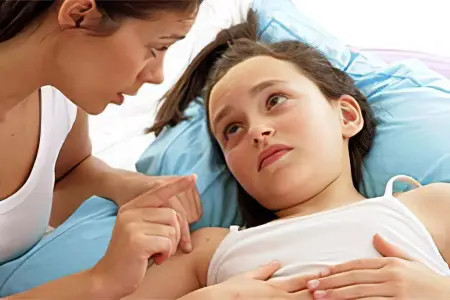
Unfortunately, helminths are frequent guests in the children’s body, because children interact with wildlife very actively: they touch animals, pick up dirty objects from the ground, eat unwashed fruits, vegetables and berries, drink unboiled water, and so on. To protect your child from helminthiasis, you need to learn how to quickly identify the symptoms of parasitic invasion so that diagnosis and treatment are carried out on time. Delay in the treatment of worms in children should not be, because parasites are not at all as harmless as it might seem at first glance.
The symptoms of helminthiases in children differ from the stage of the disease (acute or chronic) and the type of helminths, of which there are a great many in nature: the human body can become a “shelter” for more than 100 types of worms. However, the most common among them are pinworms and roundworms.
In Russia, more than 2 million cases of contacting a doctor with helminthic invasion are recorded during the year. Judging by the number of anthelmintic drugs sold, the actual number of infected people is 10 times higher, and about 80% of patients are children. Helminthology knows more than 300 species of parasites, 70 of them affect the inhabitants of Russia. Worms in children – erased symptoms, the absence of specific manifestations.
Infection with helminths can occur by airborne droplets, through the skin or by the fecal-oral route.
Types of worms affecting children
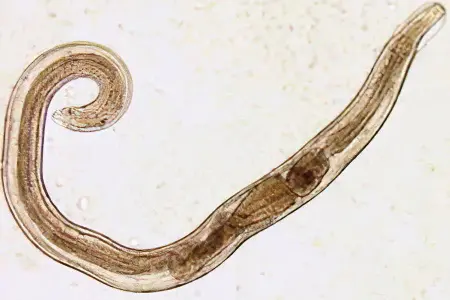
Helminths living and multiplying in the human body are divided into 3 groups:
Nematodes, or roundworms – pinworms (causative agents of enterobiasis), roundworms (causative agents of ascariasis), trichinella (causative agents of trichinosis), whipworms (causative agent of trichocephalosis), etc. This group of helminths is more common in young children.
Cestodes, or flat (tape) worms – echinococcus, bovine tapeworm (the causative agent of teniarhynchosis), rat tapeworm (the causative agent of hymenolepiasis), pork tapeworm (the causative agent of teniasis).
Trematodes, or flukes – Siberian, or cat fluke (the causative agent of opisthorchiasis), liver fluke (the causative agent of fascileosis), etc.
The place of localization of parasites is the digestive tract, liver, brain, lungs, heart, retina, bile ducts and gallbladder, pancreas. In the body, helminth larvae and adults move with the bloodstream.
How does infection occur in children and why?
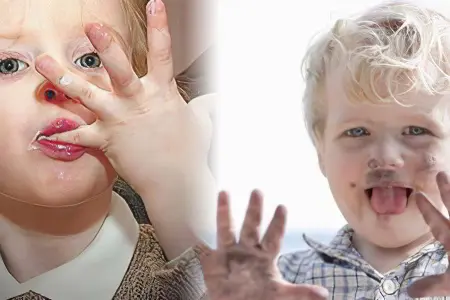
The vast majority of cases of helminthic invasion occur in nematodes (ascariasis, enterobiasis, trichocephalosis). Infection with cestodes and trematodes takes from 2 to 5% of all cases of helminthiasis. The cause of infection with tapeworms and flukes is traveling to the tropics and subtropics, eating poorly fried or boiled meat, game, fish (infection with a wide tapeworm), as well as contact with animals that carry the invasion.
Roundworms and pinworms enter the child’s body when eating food with dirty hands, when eating poorly washed berries, fruits and vegetables, when in contact with animals or with carriers of ascariasis and enterobiasis.
When children are infected with pinworms, self-infection often occurs when thousands of eggs are transferred to toys, linen, household items, dishes, door handles on the hands with which the child combed the skin around the anus. He re-infects himself and infects his family members.
Preschool children taste everything that comes into their field of vision. Therefore, places of frequent contact of children with each other (playgrounds and kindergartens, playrooms in developing and shopping centers) become breeding grounds for helminth eggs. The protective system of the body of a small child is not yet perfect, and the need to observe the rules of hygiene has not yet developed.
The situation is aggravated by an imperfect system for detecting helminthiases. Erased symptoms, or its complete absence, may accompany the development of worms in children. That is why parents find it difficult to determine the causes of malaise in the development of complications of helminthiases.
So, for example, the development cycle of pinworms allows you to detect the symptoms of its presence only at a certain period of the development cycle. A scraping taken from a child at the wrong time can be a false negative. That is why it is recommended to take scrapings on the eggs of the worm three times: with a break of 2-3 days between them, and again, after 2 weeks.
Causes of the increased risk of infection of children with ascariasis and enterobiasis:
Irregular hand washing before eating, after walking, contact with animals;
Rare change of underwear, less than 2 times a day, or once in the morning.
Persistent habit of taking toys in your mouth, sucking your finger, biting your nails;
Lack of nail care for children;
Unsanitary conditions in the child’s home, the presence of flies and cockroaches;
Contact with pets – carriers of helminths on wool and paws after a walk;
Careless washing of vegetables, berries, herbs and fruits before eating.
Common signs of the presence of worms in a child
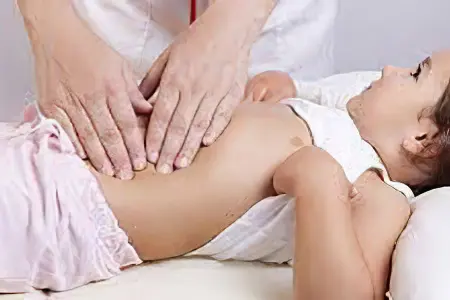
Helminths are very dangerous for the child’s body, because the products of their vital activity and decay can cause serious intoxication and allergies, up to toxic shock. In addition, helminths deprive the child of what is vital for him to grow and develop fully: vitamins and minerals. Their deficiency in the body also reduces the immunity of the child, making him vulnerable to other diseases.
Worm damage in children most often occurs in the warm season – in late spring, summer and autumn, when kids spend a lot of time outside, eat fresh unwashed fruits, vegetables and berries with dirty hands and play with yard animals.
Symptoms of worms in children can be so subtle or mild that a person does not feel that he is a carrier of the invasion. The activity of parasites is activated under unfavorable circumstances, with a decrease in the standard of living, and a drop in immunity. It is quite possible that it is the worms that are the cause of the appearance of part of the pathologies of the internal organs, oncological processes.
The first symptoms of helminthic invasion in children are weakness and irritability. The child is naughty, does not sleep well, complains of discomfort in the abdomen and headaches. Changes in appetite are observed: it either decreases or increases. Bouts of nausea, vomiting are also characteristic, stool disorders are observed (constipation alternates with diarrhea). Also, sometimes children may have an unreasonable increase in body temperature (up to 37,3 ° C). In some cases, an allergy to helminth waste products causes skin itching and rashes. In infected children, pallor of the skin is noted, dark circles appear around the eyes.
A clinical blood test for helminthic lesions of the body usually shows a high level of eosinophils, which indicates an allergic reaction. A decrease in hemoglobin is characteristic.
Signs of pinworms in children
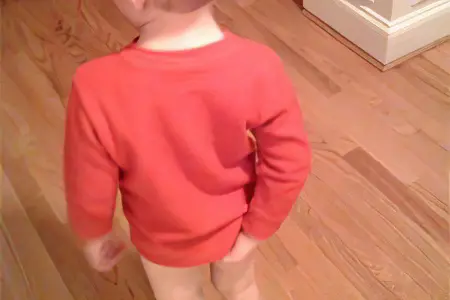
Pinworms are helminths that cause enterobiasis, they are small worms up to 1 cm long. An infected child scatters pinworm eggs in his environment, on clothes, door handles, toys, dishes. For pinworms, UV radiation, boiling, and some disinfectants are dangerous. Pinworm eggs enter the mouth, from there – into the intestines. A few days later, larvae appear from the eggs, they become sexually mature and are ready for reproduction and egg laying. One life cycle of a pinworm is only 2 weeks.
A pronounced symptom of these worms in children is nocturnal itching in the folds of the anus, when the body warms up in a warm bed, and its muscles relax. The pinworm crawls onto the skin near the anus, and lays more than 5000 eggs in its folds. Combing the irritated skin of the anal region, the child spreads these eggs under the nails. In addition to itching, skin damage from scratching can be detected in a child.
Additional symptoms of enterobiasis in children:
Restless sleep due to disturbing itching, possible insomnia, crying at night;
Weight loss, insufficient weight gain due to age;
Excitability, fatigue, whims, attention deficit, memory impairment;
Enuresis in girls due to pinworms in the urethra;
Vulvovaginitis due to irritation of the vagina by helminths crawling there, less often – inflammation of the appendages, uterus;
The development of acute appendicitis due to the accumulation of pinworms in the caecum;
Nocturnal grinding of teeth is a suggestive symptom;
Digestive disorders – dysbacteriosis, enterocolitis, diarrhea;
Anemia, increased morbidity due to a deficiency of nutrients, vitamins, trace elements;
The phenomena of intoxication, as a result of toxic poisoning of the body (weakness, weight loss, nausea, headache).
Signs of ascariasis in a child
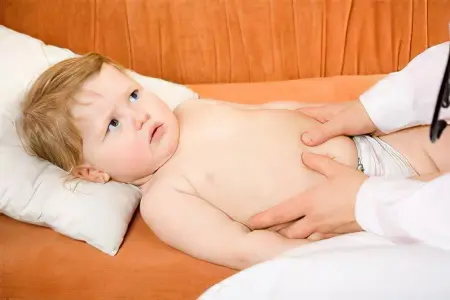
According to the statistics of laboratory studies, the defeat of children with worms is 80% of the total. Worms in children are a serious problem for medicine, as worms deprive the child of nutrients, lead to organ pathologies, complications.
Ascariasis is one of the most dangerous types of worms in children. With a massive invasion, roundworms can penetrate into any organ of the human body: intestines, liver, brain, lungs, pancreas, gallbladder, heart. Ascaris eggs enter the human mouth from the soil with dirty hands or food, where they are transferred from soil, sand, flies and cockroaches.
From the oral cavity, eggs with food enter the intestines, where they develop into larvae within 3 months. The grown larvae migrate through the blood vessels to other organs. There are symptoms such as hyperthermia up to + 38 ° C, weakness, dry cough with blood in the sputum, increased fatigue. When conducting an X-ray examination, moving infiltrates in the lungs are diagnosed. Often, a child with lung damage develops pneumonia, bronchitis, bronchial asthma.
The primary phase of ascariasis is characterized by an increase in lymph nodes, liver, spleen. Reaction to the waste products of ascaris – allergic reactions in the form of urticaria of the hands and feet, dermatoses.
The secondary, late intestinal phase of ascariasis, which occurs 3 months after infection, roundworms return to the intestine. They get there along with sputum from the lungs, swallowed by the child. Symptoms of this period are digestive disorders (abdominal pain, constipation, diarrhea, sudden weight loss, anus irritation, flatulence. Reduced immunity cannot protect the body from infections, pustular lesions of the skin and mucous membranes occur, stomatitis with frequent relapses.
The nervous system of the child suffers from the toxic effect of ascaris on the body. Children have mental disorders – sleep disturbances, nightmares, seizures of the epileptic type. Ascariasis causes serious consequences: inflammation of the peritoneum, appendicitis, intestinal obstruction due to the accumulation of ascaris in its lumen, obstructive jaundice due to larvae entering the bile ducts.
Signs of other helminthic invasions
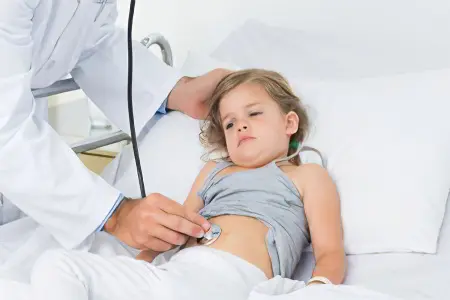
Worms in children trichuriasis (causative agent – whipworm) – the symptoms are minimal. Dyspepsia, bloody diarrhea, constipation, flatulence, anemia are possible; with prolonged intoxication, a lag in the development of children of primary preschool age is diagnosed.
Another worm in children – hymenolepiasis (causative agent – rat tapeworm) – has no specific symptoms. There may be a disorder of the digestive tract – abdominal pain, nausea and vomiting, constipation, followed by diarrhea, heartburn. The child has decreased appetite, headache, increased salivation, allergic manifestations, rhinitis of unknown etiology.
Worms in children – opisthorchiasis (causative agent – Siberian, cat fluke) – enlarged lymph nodes, allergic rashes are diagnosed, changes in the blood formula (ESR and the number of eosinophils are increased, hemoglobin is lowered). Additionally – low-grade fever, catarrh of the upper respiratory tract, digestive disorders. There are symptoms of gastritis, hepatitis, pancreatitis, myocardial dystrophy.
Diphyllobothriasis (causative agent – a wide tapeworm transmitted through fish that has not undergone full culinary processing) – anemia, allergies, digestive disorders, pain in the epigastric region.
Toxocariasis (causative agent – toxocara) – pets that transmit helminth eggs to humans become carriers of the disease. The most common cases of toxocariasis are preschool children in contact with cats and dogs. Symptoms – allergic cough, pruritus, swelling of the face, fever, hepatosis, swollen lymph nodes. Frequent eye damage – keratitis, chorioretinitis, ophthalmitis, which can become irreversible.
Treatment of worms in children
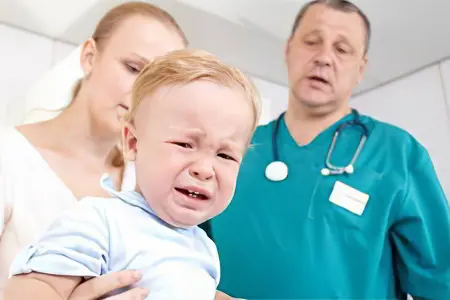
Treatment of worms in children depends on the type of parasites and the degree of the disease. Usually drug therapy is required. It is also often necessary to take laxatives and follow a special diet. After the helminths are removed from the child’s body, he needs to restore immunity and normalize the functioning of the digestive system.
For the prevention of helminthiasis, it is necessary to ensure that the child observes the rules of hygiene, eats washed fruits and vegetables, drinks purified water and boiled milk.
How to remove worms from a child?
Modern drugs for the treatment of helminthiasis are divided into 2 categories, some have a wide spectrum of action, others are selectively active, they are selected for the treatment of a certain type of helminthic invasion. Self-medication with anthelmintic therapy is unacceptable, since the drugs of this pharmacological group have severe toxicity. Only an infectious disease specialist, a parasitologist can choose the right remedy and a therapeutic dose.
At the same time, antihistamines are prescribed to prevent an allergic reaction to drug components and waste products of worms. In the treatment of young children, drops and suspensions are used, for older children – tablets (Zirtek, Loratadin, Zodak, Tsetrin).
Medicines most commonly used for the treatment of hookworms in children and their analogues:
Pyrantel (Pirvinium, Kombantrin, Helmintox, Nemocide);
Decaris – Levamisole;
Mebendazole (Termox, Warmin, Vermox, Mebex, Vermakar);
Albendazole (Vormil, Nemozol, Gelmodol-VM).
The long-used drug Piperazine, the safest for the child’s body, has not lost its value. In the treatment of severe invasion, Mebendazole is most effective. This remedy has a very valuable quality – it acts not only on adult helminths, but also on their eggs and larvae.
To eliminate the possibility of reinvasion, the treatment of enterobiasis is repeated after 2 weeks.
Prevention of helminthic invasions
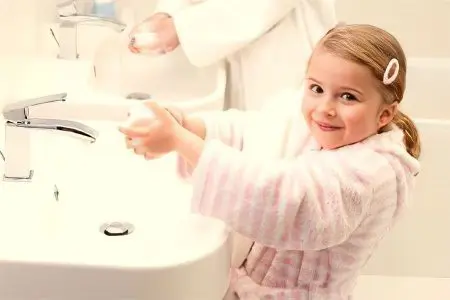
Preventive measures for the prevention of helminthiasis:
Education in children of persistent habits of observing the rules of hygiene (washing hands before eating, after going to the toilet, a ban on licking nipples, toys, household items that have fallen on the floor or on the ground, sand);
Elimination of the habit of biting nails, pencils, sucking fingers;
Fight against mosquitoes, flies, cockroaches;
Complete cooking of fish, meat (at least 40-60 minutes);
Carrying out anthelmintic prophylaxis in pets;
Thorough washing of vegetables and fruits before eating;
Keeping the child’s nails in a well-groomed condition, they must be clean and trimmed;
Ironing underwear for children with a hot iron;
Changing the child’s underpants and washing the area around the anus in the morning and evening to prevent enterobiasis.
To prevent pinworms from spreading through bed linen, it is enough to wear tight panties for the child at night.
Answers to frequently asked questions about worms in children

Why is the presence of worms dangerous? Parasites are the source of infection. They are multicellular organisms for which humans are the main or intermediate host. Helminths use the resources of the human body, live and multiply in it.
What tests should be done to determine the presence of worms? The most common are microscopic examination of feces for the presence of worm eggs in children, as well as enzyme immunoassay of blood serum to determine the antigen to parasites – a kind of immune response to the invasion of worms.
How to deal with worms? If children have symptoms of worms, to confirm the assumption, you need to do an enema and examine the excreted feces. Possible confirmations of worms in children are inclusions that look like thread trimmings, hair, sand, white-pink mucous cords, fecal stones. To clarify the type of parasites, an analysis of feces for worm eggs should be carried out. It is possible that the laboratory will give a negative result. An enzyme-linked immunosorbent assay will help confirm or refute the diagnosis. This study is carried out during the day, can reveal up to 15 varieties of helminths. Worms in children – a reason for the early start of treatment, a thorough hygienic cleaning of the house. Mandatory daily change of bed and underwear, ironing it with a hot iron on both sides. The appointment of medicines for the treatment of helminthiasis is carried out by an infectious disease specialist.
Is there a need for preventive anthelmintic measures? Yes, to prevent worms in children, it is recommended to carry out such prophylaxis at least once every six months.
Is it possible to get worms from other children? A child with a strong immune system is unlikely to become a target for parasites. In order for helminthiasis to develop, prerequisites are needed in the form of malnutrition, a deficiency in food of vitamins and nutrients. In the human gastrointestinal tract, helminth eggs regularly penetrate, however, infection in most cases does not occur. Recommendations for drug prevention of helminthic invasion twice a year do not always need to be followed. In most cases, it is enough to wash your hands thoroughly, regularly clean your home, use only clean underwear and bed linen, and diversify your diet so you never know what helminthiasis is.
Can a child get worms from pets? On the dirty paws of pets with access to the street, there may be helminth eggs that the animal brought along with street dirt. Wet cleaning with disinfectant solutions, washing paws, and restricting animals’ access to the nursery will help save the situation. Specific parasites of dogs and cats are not dangerous to humans, however, they can become a source of no less dangerous diseases of worms in children, for example, toxoplasmosis.
Is it possible to identify worms using computer diagnostics? State medical institutions in Russia do not practice computer bioresonance express diagnostics, which is widely advertised by alternative medicine centers. This technology is based on fixing the bioelectric potential of cells of various tissues and organs. Deviations of the magnetic field in a particular organ, according to the creators of the method, indicate pathologies. Since this method is not well developed, inaccurate data can lead to overdiagnosis of non-existent worms in children. Electropuncture diagnostics according to Voll measures the electrical potential at bioactive points on the human body. Even with absolute health, this diagnostic method is able to show “traces of invasion”, the consequences of contact with parasites. You should not rely on such data for anthelmintic treatment. Classical methods of studying feces and blood for antigens to parasites are quite objective.
Does kefir fungus help in the treatment of worms? Data confirming the effectiveness of this method of treatment of worms in children are not available. Adherents of kefir fungus treatment of any diseases cannot provide evidence in favor of such an action of kefir fungus.









